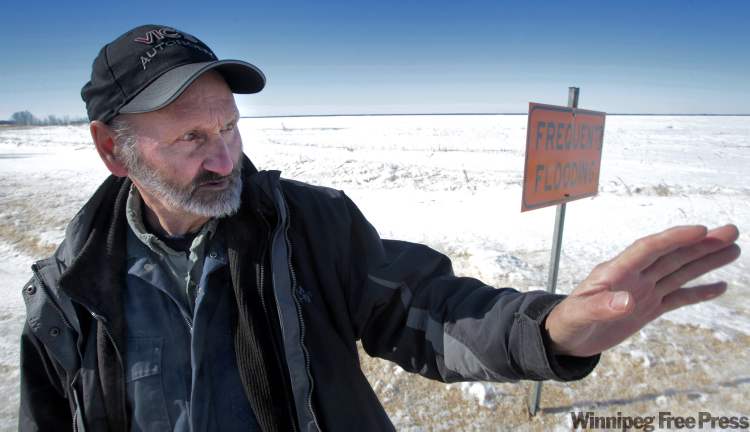Shoal Lakes threaten to swamp 60 properties
Farmers want drain installed to prevent flooding
Advertisement
Read this article for free:
or
Already have an account? Log in here »
To continue reading, please subscribe:
Monthly Digital Subscription
$1 per week for 24 weeks*
- Enjoy unlimited reading on winnipegfreepress.com
- Read the E-Edition, our digital replica newspaper
- Access News Break, our award-winning app
- Play interactive puzzles
*Billed as $4.00 plus GST every four weeks. After 24 weeks, price increases to the regular rate of $19.00 plus GST every four weeks. Offer available to new and qualified returning subscribers only. Cancel any time.
Monthly Digital Subscription
$4.75/week*
- Enjoy unlimited reading on winnipegfreepress.com
- Read the E-Edition, our digital replica newspaper
- Access News Break, our award-winning app
- Play interactive puzzles
*Billed as $19 plus GST every four weeks. Cancel any time.
To continue reading, please subscribe:
Add Free Press access to your Brandon Sun subscription for only an additional
$1 for the first 4 weeks*
*Your next subscription payment will increase by $1.00 and you will be charged $16.99 plus GST for four weeks. After four weeks, your payment will increase to $23.99 plus GST every four weeks.
Read unlimited articles for free today:
or
Already have an account? Log in here »
Hey there, time traveller!
This article was published 25/03/2011 (5319 days ago), so information in it may no longer be current.
INWOOD, Man. — John Dyck has muskrats living on the frozen marsh that used to be his hayfield. Wallace Morin has built a ring dike around his farmhouse even though he lives six kilometres from any official body of water.
Leonard Dziedzic saw pelicans swimming last summer above the spot where he used to store his bales. Howard Hilstrom has already lost half of his 6,000 acres of farmland as well as one-third of his 300 cows.
These four farmers have the misfortune of living at the edge of the Shoal Lakes, once-separate bodies of water east of Lake Manitoba in the province’s Interlake region, that have merged into a single super-lake over the past decade, swallowing up thousands of acres of private and Crown land in the process.

Like Devils Lake in North Dakota, what used to be West, East and North Shoal Lakes have no natural outlet. This Interlake drainage area relied on evaporation to handle any water that flows in from nearby sloughs and marshes.
Unprecedented precipitation over the past decade has overwhelmed the system. The Shoal Lakes threaten no less than 60 land owners, including 50 cattle farmers still struggling to recover from last decade’s BSE crisis.
“We’re at the end of our rope. We used up our RRSPs. We used up our savings. The line of credit is maxed. The credit cards are almost maxed,” said Dyck, a 64-year-old cattleman who only managed to grow 30 of the 300 bales of hay he needed to feed his cows last summer because of the flooding. He was forced to buy the rest of the hay and spend money on gas to truck it in.
Dyck once planned to sell his farm, retire and live off the proceeds. Now, nobody wants to buy a farm partly submerged below what used be North Shoal Lake.
“I’ve worked 40 years and I have nothing,” he said. “I just want to be bought out. But nobody’s offered me a penny.”
Cattlemen living near Shoal Lake say they started warning the province about flood waters in 2000. Their predictions came true in 2005, when the lakes began merging, absorbing neighbouring bodies of water and started creeping over farms and roads.
Last spring, the province closed portions of provincial roads 415 and 518, forcing schoolchildren in the hamlet of Harperville to take a 45-minute detour to reach classes in Inwood. This year, PR 229 is expected to join them, cutting off schoolchildren living near Vestfold, another hamlet.
The once-alkaline Shoal Lakes are now full of fish, as evident by the presence of a family of river otters that’s taken up residence across from Dyck’s farm.
Hilstrom, a former Reform and Canadian Alliance MP for Selkirk-Interlake, suspects the provincial government is happy to see these creatures replace agriculture in the area.
“The province seems to want this land for wildlife management areas and as a place to store water,” he charged, blaming both NDP and Progressive Conservative governments for years of inaction on drainage and compensation.
“We’re going broke out here. Just when we had the chance to recover from BSE, we can’t take advantage of good cattle prices.”
Dziedzic, Morin and Larry Torske, a retired teacher who farms cattle north of Inwood, are among the farmers who want to keep going. They want the province to cut a drain to carry flood waters west to Lake Manitoba, at a potential cost of $24 million.
Neighbouring municipalities also support this option — still years away from construction — because the Shoal Lakes would otherwise spill southeast into Grassmere Drain, which flows past Stonewall and through West St. Paul to the Red River.
The lakes only need to rise 30 or 40 centimetres higher before they spill into Grassmere Drain, with unknown and potentially disastrous effects on downstream agricultural and residential communities, said Steve Topping, executive director of Manitoba Water Stewardship.
There’s only a one-in-10 chance of that happening this year, Topping added. But he’s certain about another statistic: No matter what happens this spring, there will be record-high floodwaters at the Shoal Lakes.
The only creatures who’ll be pleased are the muskrats.
“Look at them all,” said Dyck, pointing to mounds of wood that mark where aquatic rodents have made a home.
“They know they’re here to stay.”
bartly.kives@freepress.mb.ca

